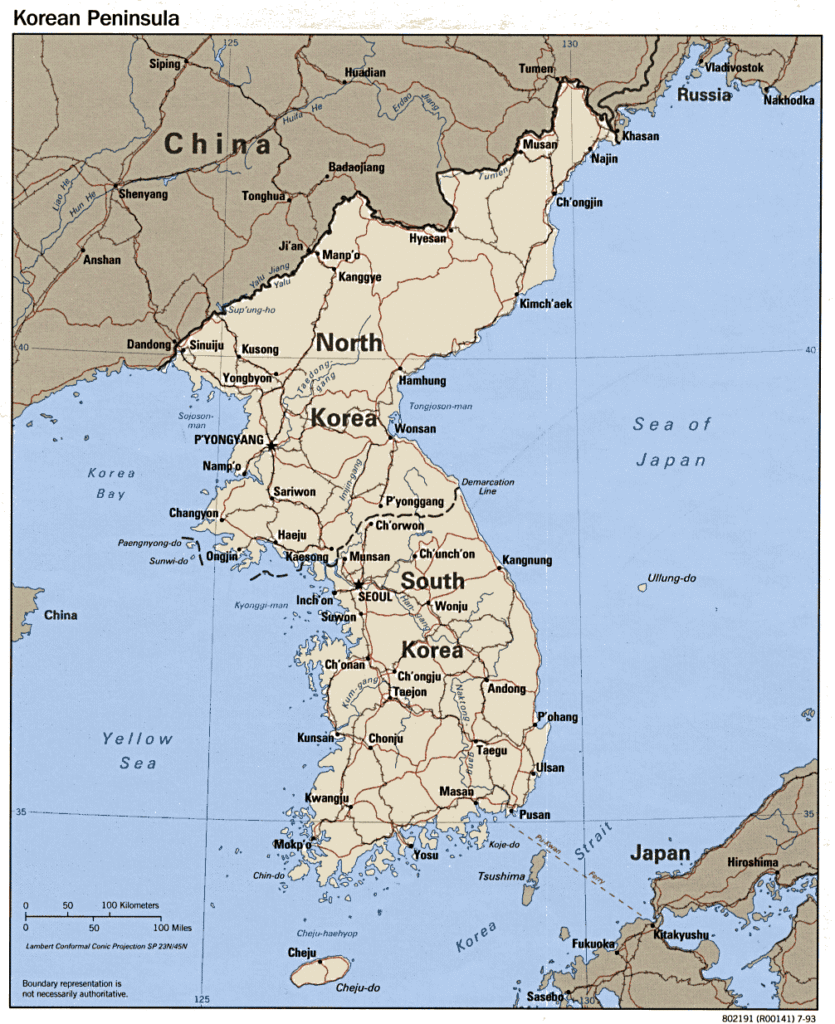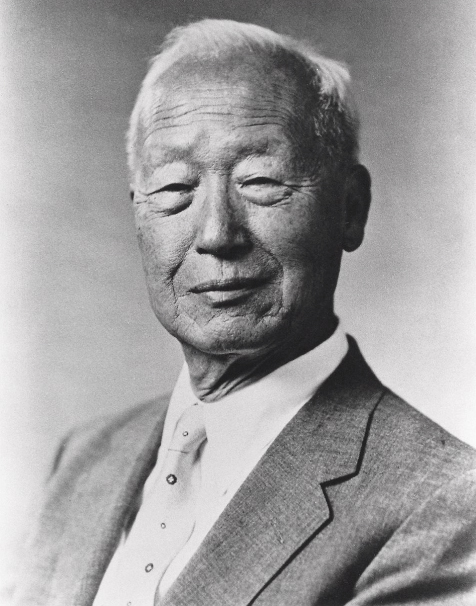American wars have a story and a legacy in popular culture. That legacy tends to color the way that we view the history and nature of those conflicts and those involved with and surrounding them. As America’s first major conflict after World War II in the fight against Communism, the Korean War is often used as an example of just war, with clear good and evil actors, and it is even characterized as one of America’s most moral wars. This is further cemented by what is seen as a demonstrably positive intended outcome: a thriving, democratic, prosperous South Korea, in contrast with the still-Communist North.
But, given our past experience with debunking war legacies, I was skeptical that this story actually checked out, that the popular facts surrounding it may be, in fact, more nuanced. Is the Korean War really such an obvious win and a clear, easy case of justified war? Or has the history been obscured here as well?
Why Was the Korean War Even Necessary?
Historian Jerry Sweeney has humorously quipped, “when war broke out in South Korea in 1950, Americans scrambled to find an atlas.” This rings equally true for most Americans today and I can still recall a time when I did not understand any of its details. Why the Communist split at the 38th parallel? Why the Soviet influence? Why the US involvement at all?
I still remember my thrill at the revelation that the split in Korea actually dates back to the end of World War II. Recall that, as part of the agreements made between the Allied forces at the Yalta conference that Stalin agreed to join in the Pacific theater three months after Germany had been defeated. This involved the invasion of Manchuria and the collaborative explusion of the Japanese from mainland Asia. However, Truman’s preemptive nuclear bombing of Japan sought to end the conflict with Japan before Stalin could become involved, thus causing Stalin to move forward the timeline for the planned invasion. This invasion also included Korea and, after joint discussions as to its eventual fate, a US agreement drafted and agreed to by the Soviets created the joint occupation and, at first, temporary, partition of Korea at the 38th parallel, the Soviets occupying the North and the US occupying the South.

In a very real sense, the dismal situation in Korea was both the object of further intervention and the result of past intervention. Recall that the invasion and occupation of the Korean Peninsula was deemed necessary at the time to force out the occupying Japanese, who both the US and Soviets were then at war with. And yet, prior to World War II, the US had actually worked to bring about the very Japanese occupation they now found themselves ending. As the great Murray Rothbard recounts, “After helping the European powers suppress the nationalist Boxer Rebellion in China in 1900, the U.S. also helped push Russian troops out of Manchuria” and “in 1904, President Theodore Roosevelt egged Japan on to attack Russia, and Japan succeeded in driving Russia out of Manchuria and ending Russia’s economic concessions. Roosevelt readily acceded to Japan’s resulting dominance in Korea and Manchuria, hoping that Japan would also protect American economic interests in the area.”
Thus, decades later, the very power that the US had encouraged Japan to expel is the very power that it invited back in. The US-Soviet alliance during World War II is often taken for granted but we should remain ever amazed that within the span of a few short years US-Soviet relations moved from eager cooperation to bitter rivalry. And under the leadership of Truman, this original agreement was then reneged on, effectively making such agreements with the Soviets moot to begin with. So it would seem that Stalin’s help was not, ultimately, needed and that these agreements thus also subjected China, Manchuria, and Korea to unnecessary Communism and Soviet occupation, along with the eventual suffering that would follow.
Was South Korea A Bastion of Freedom?
One of the latent assumptions regarding the war was that of US support and defense of the freedom and democracy in South Korea. At the time, South Korea was being ruled at the hands of the US-backed Syngman Rhee. During the Japanese occupation of Korea, Rhee was in exile in the United States. But in 1945, with World War II wrapping up in the Pacific, Rhee was brought back to South Korea by the US and maneuvered into power under the US Korean Military Government. This was done despite an indigenous government forming organically by the Korean peoples themselves which was suppressed from growing any further at the time. Purely from a libertarian perspective, by controlling the makeup and influence of the native peoples in this way, the US support of Rhee and others had the effect of “regulating Korean political life as if the country were a defeated enemy and not a friendly state liberated from a common foe and with a right to independence and self-determination.”

Rhee and the USAMGIK may have had positive motives, ones of promoting free markets and free enterprise, but the methods used and the lack of recognizing the existent post-colonial realities proved ineffective or even counterproductive. For instance, after being established, the government sold off large amounts of previously Japanese held capital assets. Yet, given the history of colonial conditions, those most able to afford such property at the time were those who had most collaborated with and profited from the Japanese occupation. As Alfred Crofts, a member of USAMGIK at the time, considered, “with half the wealth of the nation ‘up for grabs’, demoralization was rapid.” Worse, the Americans also allowed many former Japanese collaborators and even Japanese themselves to retain positions in the new administration, much to the chagrin of any Koreans who had previously fought for freedom from such influence.
In typical Cold War fashion, any Koreans that opposed the Rhee regime was assumed to have succombed to Communist influence and, in the words of John Gunther, “almost any Korean not an extreme rightist was a communist and potential traitor.” As William Blum describes the period, “so reluctant was Rhee to allow an honest election, that by early 1950 he had become enough of an embarrassment to the United States for Washington officials to threaten to cut off aid if he failed to do so and also improve the state of civil liberties.” And, as seen by the “more moderate” election results in South Korea as of May 30 in 1950, when these elections were finally opened up, Rhee’s party lost control of the Korean National Assembly.
These factors and the overall tyrannical rule of Rhee led to public resentment and guerrilla rebellions from 1946 on. Stanley Earl, a labor advisor in South Korea at the time, thought that “an internal South Korean rebellion against the Rhee Government would have occurred if the forces of North Korea had not invaded.” Gregory Henderson, a US diplomat in Korea during the period, estimated that “probably over 100,000 were killed without any trial whatsoever” at the hands of Rhee’s forces during the war. Even more sadly, Mark Gayn writing for the Chicago Sun, attested that American troops sometimes participated in South Korean guerrilla suppresion, that they even “fired on crowds, conducted mass arrests, combed the hills for suspects, and organized posses of Korean rightists, constabulary and police for mass raids.” To drive the point home, Gunther also notes that, “at the time of the outbreak of war in June 1950, there were an estimated 14,000 political prisoners in South Korean jails.”
Was North Korea Solely to Blame?
One common misconception or assumption in evaluating the Korean War is one of an otherwise innocent South Korea and its unjustifiably aggressive northern neighbor, or as William Blum characterizes it, that “the war in Korea was an unambiguous case of one country invading another without provocation. A case of the bad guys attacking the good guys who were being saved by the even better guys.”
As you might expect, this characterization simply does not bear itself out. The impression given in many histories is that of a sudden, unprovoked invasion by North Korea in a fairly black-and-white manner on June 25 of 1950. What had actually been taking place in Korea involved many months of repeated conflicts across the 38th parallel demarcation line. For instance, the US State Department via Ambassador Philip C. Jessup reported in April of 1950, some few months before the actual North Korean invasion, that, “there is constant fighting between the South Korean Army and bands that infiltrate the country from the North. There are very real battles, involving perhaps one or two thousand men.” As well, official North Korean reports state that “in 1949 alone, the South Korean army or police perpetrated 2,617 armed incursions into the North to carry out murder, kidnapping, pillage and arson for the purpose of causing social disorder and unrest.”
Furthermore, North Korean records actually indicate the invasion was a response to prior South Korean bombardment for two days prior, June 23rd and 24th, as well as a surprise South Korean assault on the town of Haeju on the 25th, the capture of which is consistent with South Korean field reports on the 26th. It is also important to note that, though the UN later claimed sole North Korean aggression, “no United Nations group—neither the UN Military Observer Group in the field nor the UN Commission on Korea in Seoul—witnessed, or claimed to have witnessed, the outbreak of hostilities.” Given these considerations, it seems reasonable to understand the North Korean invasion not as a new and unprecedented escalation but “as no more than the escalation of an ongoing civil war.”
In January of 1950, the US State Department announced that their perimeter of defense included Japan and the Phillippines but excluded Korea. One of the reasons for this seems to have been the lack of any perceived military value. But another was likely an opposition to Rhee himself. As leader of South Korea, Rhee had repeatedly called for unification by force and as late as June of 1950, just before the war officially broke out, had still advocated marching north. The New York Times recalled that, “on a number of occasions, Dr. Rhee has indicated that his army would have taken the offensive if Washington had given the consent” and that “the warlike talk strangely [had] almost all come from South Korean leaders.” These concerns are echoed by General John Roberts who testified that the South Koreans were not even allowed to arm themselves adequately for defense “because America feared they would attack the North Koreans.”
Indeed, Rothbard himself reported that, “[Representative] Howard Buffett was convinced that the United States was largely responsible for the eruption of conflict in Korea; for the rest of his life he tried unsuccessfully to get the Senate Armed Services Committee to declassify the testimony of CIA head Admiral Hillenkoeter, which Buffett told me established American responsibility for the Korean outbreak.”
It was also considered that Acheson’s declaration itself, that Korea lay outside of the US sphere of defense, along with its ongoing support of Nationalist China, had invited and magnified the Communist opposition in the region. The northern invasion was approved of by Stalin and, while disagreeing with the Communist desires for Korea, in hindsight, his fears and concerns were actually rather legitimate. Vladislav Zubok relates that Stalin had an “expectation that the United States might eventually turn [South Korea] into a beachhead for a return to the Asian mainland in alliance with a resurgent Japan.” Ultimately, the invasion itself turned South Korea into exactly that.
The Bottom Line
As we have just seen, the facts concerning the outbreak of the war already fail to line up with its commonly held understanding and characterizations. In part 2 of this series, we will consider other facets of the conflict that impact it being a just war, the way in which it was begun, the way in which it was fought, and whether the outcome truly warranted its being waged at all.

